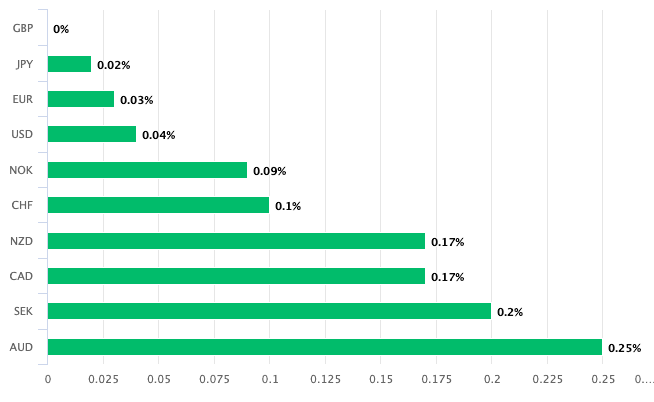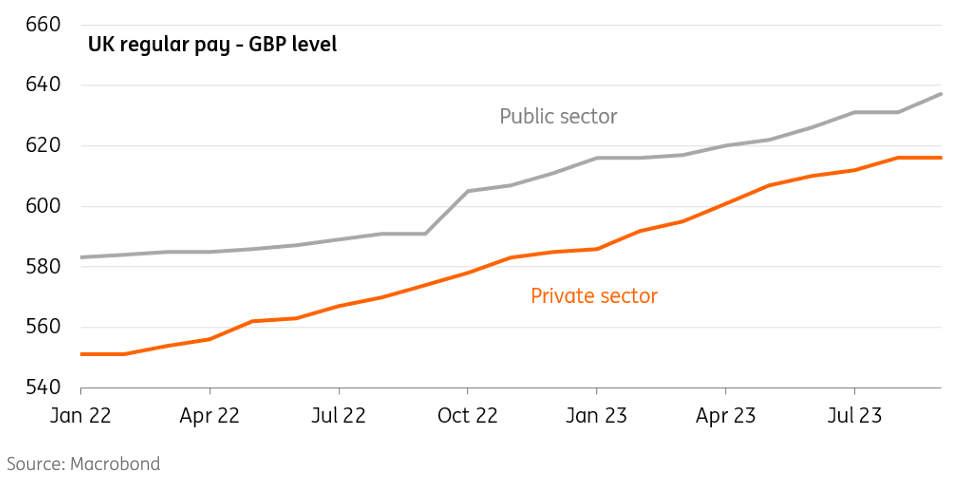Pound Sterling Bid vs. Euro & Dollar Following Hot Wage Print
- Written by: Gary Howes
-

Image © Adobe Images
The British Pound rose against the Euro, Dollar and most other currencies as an initial reaction to surprisingly strong UK wage numbers and news that the UK unemployment rate was unchanged in September.
The ONS said the unemployment rate remained static at 4.2% in September, defying expectations for a rise to 4.3%. The ONS says 54K jobs were created in the three months to September, which defies an expectation for a reading of -198K and marks an improvement of the previous month's reading of -82K.
But the currency market focus will have been on the UK earnings index (with bonuses), which increased 7.9% in September according to the ONS, outstripping the 7.4% increase the market was expecting, while August's increase was revised higher to 8.4%.
The Pound to Euro exchange rate rose to 1.1482 in the minutes following the release, and the Pound to Dollar exchange rate rallied to 1.2285. In fact, Sterling moved higher against all peers, confirming the idiosyncratic impact of the data:

Above: GBP outperforms in G10 following the data release. Set up a daily rate alert email to track your exchange rate OR set an alert for when your ideal exchange rate is triggered ➡ find out more.
A rise in the Pound reflected a rise in UK bond yields, which signals investors judge this set of labour market figures as heading in the opposite direction from what the Bank of England expects. The figures confirm the labour market remains 'tight' and competition for staff will keep wages elevated, making it harder for the Bank to bring inflation back to its 2.0% target.
"The pound was yesterday’s main gainer and continued marching north today after the UK employment data for September largely beat expectations, with the unemployment rate holding steady instead of rising, and average weekly earnings including bonuses slowing by less than forecast," says Charalampos Pissouros, Senior Investment Analyst at XM.com.
The Pound has fallen over recent weeks as markets built expectations for a series of rate cuts at the Bank of England in 2024, but this particular set of figures suggests such expectations are premature.
Indeed, we reported on Monday that HSBC says the first Bank of England cut will only fall at the beginning of 2025, well behind market expectations for mid-year 2024. If the market rows back on this expectation, the Pound can find support in a foreign exchange market focussed on relative interest rate expectations.
Although the headline figures suggest the jobs market is not 'loosening' as quickly as some might have expected, underlying trends do continue to suggest wages will ultimately fall.
Job vacancies continue to fall; 957K jobs were available in the August to October period, a decrease of 58K from May to July 2023.
"Wages are growing in real terms, which should herald an end to the worst of the living standards squeeze. However, it is only a matter of time before the cooling of the labour market translates into lower wage growth," says Jake Finney, economist at PwC.
Above: Private sector wage growth is slowing. Image courtesy of ING.
"With wage growth continuing to ease and signs that a further loosening in labour demand lies ahead, higher interest rates appear to be gradually working. But our view that wage growth will ease only slowly will mean the Bank of England keeps interest rates at 5.25% until late in 2024," says Ashley Webb, UK Economist at Capital Economics.
Labour demand was stronger than Capital Economics had expected (+54K in the three months to September), but this improvement was offset by a 63K rise in the supply of workers in the same period.
"This was enough to keep the unemployment rate unchanged at 4.2%," explains Webb.
Capital Economics says the labour market continues to cool and will gradually feed through into an easing wage growth.
"Our view that wage growth will fall only slowly means that the Bank won’t be able to cut rates until late next year. But when rates are eventually cut, we think they will be reduced further than most expect," says Webb.
For the Pound, the focus now turns to the midweek inflation release for October. Inflation is anticipated to have fallen to 4.8% from 6.7%.
Should the drop be bigger than expected, the Pound can come under some near-term pressure. However, we see limited upside on any significant upside surprise as this would likely raise worries about the UK's economic outlook.






